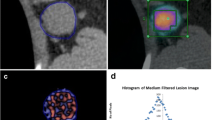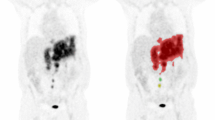Abstract
Purpose
The purpose of this study was to determine if quantitative SUV-related, volumetric FDG PET parameters, and texture features (SPs, VPs, and TFs, respectively) were useful to evaluate and predict response and recurrence after chemotherapy in follicular lymphoma (FL).
Methods
Pre- and posttreatment FDG PET examinations in 45 FL patients were analyzed retrospectively. In addition to SPs in the representative lesion, metabolic tumor volume (MTV) and total lesion glycolysis (TLG) were calculated as VPs for the representative and whole-body lesions. Six TFs were calculated in the pretreatment representative lesion. Response results with reduction of SPs or VPs after treatment (Δ) were compared to the Lugano classification based on visual assessment. SPs, VPs, and Δ of them as well as TFs were also evaluated if they allow prediction of response and recurrence after chemotherapy.
Results
Quantitative assessment with SPs and VPs provided 89% and 93–96% concordant results, respectively, with Lugano classification. Among pretreatment PET parameters, low gray-level zone emphasis (LGZE) in TFs solely showed statistical significance to predict complete response. All of posttreatment and Δ of SPs and VPs were considered as the predictors of progression free survival in the univariate Cox regression analysis, but none of them was the predictor in the multivariate analysis.
Conclusion
This study demonstrated that quantitative PET parameters were applicable to evaluate treatment response in FL. Texture analysis showed promise in predicting treatment response. Although posttreatment and Δ of PET parameters were the candidates, all of them proved to have limited value in predicting recurrence after chemotherapy.

Similar content being viewed by others
References
Dreyling M, Ghielmini M, Rule S et al (2016) Newly diagnosed and relapsed follicular lymphoma: ESMO clinical practice guidelines for diagnosis, treatment and follow-up. Ann Oncol 27(suppl 5):v83–v90
Pyo J, Won Kim K, Jacene HA et al (2013) End-therapy positron emission tomography for treatment response assessment in follicular lymphoma: a systematic review and meta-analysis. Clin Cancer Res 19(23):6566–6577
Schöder H, Noy A, Gönen ML et al (2005) Intensity of 18fluorodeoxyglucose uptake in positron emission tomography distinguishes between indolent and aggressive non-Hodgkin’s lymphoma. J Clin Oncol 23(21):4643–4651
Wu X, Pertovaara H, Korkola P et al (2014) Correlations between functional imaging markers derived from PET/CT and diffusion-weighted MRI in diffuse large B-cell lymphoma and follicular lymphoma. PLoS One 9(1):e84999
Cheson BD, Pfistner B, Juweid ME et al (2007) Revised response criteria for malignant lymphoma. J Clin Oncol 25(5):579–586
Cheson BD, Fisher RI, Barrington SF et al (2014) Recommendations for initial evaluation, staging, and response assessment of Hodgkin and non-Hodgkin lymphoma: the Lugano classification. J Clin Oncol 32(27):3059–3067
Pak K, Cheon GJ, Nam H-Y et al (2014) Prognostic value of metabolic tumor volume and total lesion glycolysis in head and neck cancer: a systematic review and meta-analysis. J Nucl Med 55(6):884–890
Im H-J, Pak K, Cheon GJ et al (2015) Prognostic value of volumetric parameters of 18 F-FDG PET in non-small-cell lung cancer: a meta-analysis. European journal of nuclear medicine and molecular imaging 42(2):241–251
Li Y-J, Dai Y-L, Cheng Y-S et al (2016) Positron emission tomography (18) F-fluorodeoxyglucose uptake and prognosis in patients with bone and soft tissue sarcoma: a meta-analysis. Eur J Surg Oncol 42
Chicklore S, Goh V, Siddique M et al (2013) Quantifying tumour heterogeneity in 18 F-FDG PET/CT imaging by texture analysis. Eur J Nucl Med Mol Imaging 40(1):133–140
Orlhac F, Soussan M, Maisonobe J-A et al (2014) Tumor texture analysis in 18F-FDG PET: relationships between texture parameters, histogram indices, standardized uptake values, metabolic volumes, and total lesion glycolysis. J Nucl Med 55(3):414–422
Hatt M, Tixier F, Pierce L et al (2017) Characterization of PET/CT images using texture analysis: the past, the present … any future? Eur J Nucl Med Mol Imaging 44(1):151–165
Sharma P, Gupta A, Patel C et al (2012) Pediatric lymphoma: metabolic tumor burden as a quantitative index for treatment response evaluation. Ann Nucl Med 26(1):58–66
Song M, Chung J, Lee J et al (2013) Metabolic tumor volume by positron emission tomography/computed tomography as a clinical parameter to determine therapeutic modality for early stage Hodgkin's lymphoma. Cancer Sci 104(12):1656–1661
Kim C-Y, Hong CM, Kim D-H et al (2013) Prognostic value of whole-body metabolic tumour volume and total lesion glycolysis measured on 18 F-FDG PET/CT in patients with extranodal NK/T-cell lymphoma. Eur J Nucl Med Mol Imaging 40(9):1321–1329
Ko K-Y, Liu C-J, Ko C-L et al (2016) Intratumoral heterogeneity of pretreatment 18F-FDG PET images predict disease progression in patients with nasal type extranodal natural killer/T-cell lymphoma. Clin Nucl Med 41(12):922–926
Wahl RL, Jacene H, Kasamon Y et al (2009) From RECIST to PERCIST: evolving considerations for PET response criteria in solid tumors. J Nucl Med 50(Suppl 1):122S–150S
Tixier F, Le Rest CC, Hatt M et al (2011) Intratumor heterogeneity characterized by textural features on baseline 18F-FDG PET images predicts response to concomitant radiochemotherapy in esophageal cancer. J Nucl Med 52(3):369–378
Tateishi U, Tatsumi M, Terauchi T et al (2015) Prognostic significance of metabolic tumor burden by positron emission tomography/computed tomography in patients with relapsed/refractory diffuse large B-cell lymphoma. Cancer Sci 106(2):186–193
Hanaoka K, Hosono M, Tatsumi Y et al (2015) Heterogeneity of intratumoral 111 In-ibritumomab tiuxetan and 18 F-FDG distribution in association with therapeutic response in radioimmunotherapy for B-cell non-Hodgkin's lymphoma. EJNMMI Res 5(1):10
Orlhac F, Nioche C, Soussan M et al (2017) Understanding changes in tumor texture indices in PET: a comparison between visual assessment and index values in simulated and patient data. J Nucl Med 58(3):387–392
Meignan M, Cottereau AS, Versari A et al (2016) Baseline metabolic tumor volume predicts outcome in high-tumor-burden follicular lymphoma: a pooled analysis of three multicenter studies. J Clin Oncol 34(30):3618–3626
Nakajo M, Jinguji M, Nakabeppu Y et al (2017) Texture analysis of 18 F-FDG PET/CT to predict tumour response and prognosis of patients with esophageal cancer treated by chemoradiotherapy. Eur J Nucl Med Mol Imaging 44(2):206–214
Larson SM, Erdi Y, Akhurst T et al (1999) Tumor treatment response based on visual and quantitative changes in global tumor glycolysis using PET-FDG imaging: the visual response score and the change in total lesion glycolysis. Clin Positron Imaging 2(3):159–171
Miyabe J, Hanamoto A, Tatsumi M et al (2017) Metabolic tumor volume of primary tumor predicts survival better than T classification in the larynx preservation approach. Cancer Sci 108(10):2030–2038
Author information
Authors and Affiliations
Corresponding author
Ethics declarations
Conflict of interest
The authors declare that they have no conflict of interest.
Additional information
Publisher's Note
Springer Nature remains neutral with regard to jurisdictional claims in published maps and institutional affiliations.
About this article
Cite this article
Tatsumi, M., Isohashi, K., Matsunaga, K. et al. Volumetric and texture analysis on FDG PET in evaluating and predicting treatment response and recurrence after chemotherapy in follicular lymphoma. Int J Clin Oncol 24, 1292–1300 (2019). https://doi.org/10.1007/s10147-019-01482-2
Received:
Accepted:
Published:
Issue Date:
DOI: https://doi.org/10.1007/s10147-019-01482-2




